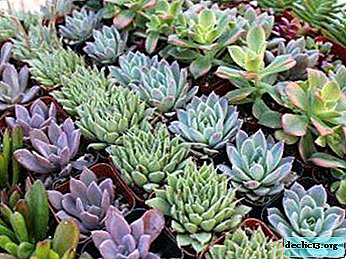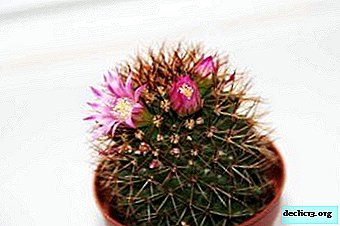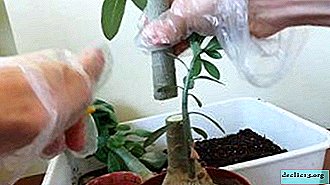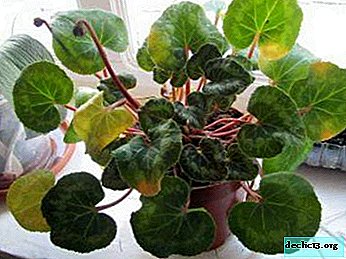The nuances of planting amaryllis and flower care. Bright photos of a beautiful plant
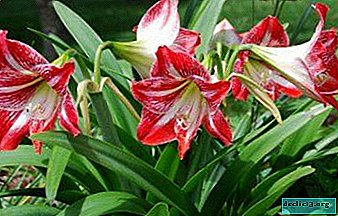
Amaryllis is considered a classic perennial bulbous plant. Its buds are very similar to lilies and have many shades. Thanks to the crossing of species, now you can see red, pink, orange, white and other colors.
The plant enjoys special attention during the flowering period, its buds are so colorful that they always cause special admiration among gardeners and lovers of flowering plants. With special care for the flower at home, you can achieve 3-4 blooms per year. The flowering period is about 16-20 days, during this period, amaryllis can produce up to 12 flowers.
How does it breed?
This flower has two methods of reproduction:
- Bulb Department: the easiest way, it can be used when transplanting a plant. It is a separation from the bulb of her children with their subsequent planting them in another pot. Flowering of a young bulb occurs approximately three years after separation.
- Seed propagation: This view is more complex and suitable for more experienced gardeners. It occurs through artificial pollination of a plant. Then there are seeds that are planted in the ground.
Photo
Next, you can see how Amaryllis looks in the photo:





Seed Growing Instructions
How to grow a plant from seeds? Growing amaryllis with seeds is a very time-consuming process and is not guaranteed.. In this process, it is necessary to take into account everything and not to miss more than one detail, otherwise the seeds simply will not sprout.
In order to grow amaryllis from seeds, you need to do a lot of work and choose the right materials. The growing process can be divided into two main stages:
- Selection of seeds and their preparation for planting: This process begins by transferring the pollen of one flower to the stigma of another. This can be done with a soft brush. In this case, the result will be better if the flower is pollinated twice.
After pollination for two weeks, a seed box appears in the plant, in which about 50-80 seeds. Ripe seeds are considered when cracks appear on the box. Seeds are small in size and have dark skin color. Before planting, this peel must be carefully cleaned, and the seed located in it should be used for planting.
- Preparation of soil and pot: For planting, you can choose any convenient pot in which the seeds will fit and during growth will not be located too close to each other.
The composition of the soil for quick germination of the seed should include ½ part of the sheet soil and ½ sod in half with humus. In the prepared soil to a depth of 0.5 centimeters, you need to plant the prepared seed and sprinkle with earth. The main condition for seed germination is air temperature + 22-25 degrees Celsius and constantly moist soil.
If all processes are performed correctly, germination occurs within a month.
You can transplant the sprouts into separate pots after the first two leaves grow. Amaryllis flowering after this type of reproduction occurs in 4-6 years.
Tip: Plant seeds immediately after collecting them. If you dry them, then the chances that they will rise are very low.We recommend watching a video about growing amaryllis from seeds:
Instructions on how to plant a bulb in a pot at home
Unlike seed propagation, bulb making is much easier and even an amateur grower can cope with this. The main thing is to follow all instructions so that the separation of children is effective.
This type of reproduction is the separation of children from the main bulb. In order for the whole process to be carried out correctly, it is necessary:
 Select and prepare the onion: this must be done in the summer when replanting a plant. For separation, you need to clean the bulb from the scales and choose a baby with separate roots. When transplanting, such a baby must be left with leaves otherwise she may die without the possibility of obtaining nutrients. Sometimes, instead of separating the baby, the bulbs use a different division method. It consists in cutting off the entire upper part of the plant with leaves, without getting out of the ground. After this, it is necessary to make 4 cuts crosswise and insert the needles into them. Over time, in their place the makings of new bulbs will appear.
Select and prepare the onion: this must be done in the summer when replanting a plant. For separation, you need to clean the bulb from the scales and choose a baby with separate roots. When transplanting, such a baby must be left with leaves otherwise she may die without the possibility of obtaining nutrients. Sometimes, instead of separating the baby, the bulbs use a different division method. It consists in cutting off the entire upper part of the plant with leaves, without getting out of the ground. After this, it is necessary to make 4 cuts crosswise and insert the needles into them. Over time, in their place the makings of new bulbs will appear.- Prepare soil and pot: usually for planting children choose a large pot with the expectation that the plant will grow rapidly. An ideal soil for this plant is a mixture of leafy ground with turf. You can also add fertilizer and sand to it. It is this composition and fertilizing the flower with fertilizers that will help to achieve its fastest flowering.
- To land: After all the land preparations, depending on the chosen method of growing the baby, you need to plant the sprout in moist soil and put it in a room with scattered light without direct sunlight. The best temperature for growth is + 22-25 degrees Celsius.
Having correctly completed all the recommendations and advice, as a result, you can get a beautiful flower that, after two years, will definitely please its first flowering. Plant transplantation is carried out in the summer after the flower arrow dries..
We recommend watching a video about planting amaryllis bulbs:
How to grow in the garden?
Can this flower be grown in the garden? Amaryllis is a very beautiful plant. Its flowers are bright and colorful. Everyone has long been accustomed to see this flower in pots or flowerpots, but some gardeners have adapted to plant this plant in open ground. This flower may well exist in environmental conditions under certain conditions.
Growing and caring for amaryllis in a flower bed has features that differ from a potted plant:
- for planting, you need to choose a suitable not too sunny place so that the flower does not burn out in the sun;
- when flowering, you need to monitor the condition of the soil and its moisture, if necessary, feed the plant;
- special attention must be paid to possible diseases and pests that a flower may encounter in the environment.
In order for the process of planting amaryllis on the flower bed to be successful, the following instructions should be followed:
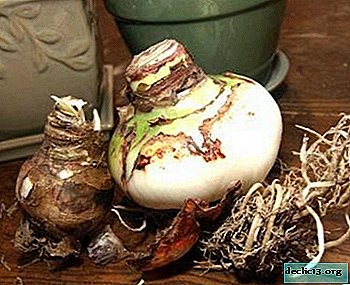 Choose a bulb to plant: if amaryllis is already growing in your house, then by multiplying it you can get new bulbs to get some beautiful flowers. But the easiest way is to choose the bulbs in a flower shop, since their flowering occurs two years after propagation, and the children of the bulb simply can not stand the environmental conditions. When choosing a bulb, you should pay attention to its condition, it should be intact without visible cracks. Before planting, the scales of the bulbs must be removed.
Choose a bulb to plant: if amaryllis is already growing in your house, then by multiplying it you can get new bulbs to get some beautiful flowers. But the easiest way is to choose the bulbs in a flower shop, since their flowering occurs two years after propagation, and the children of the bulb simply can not stand the environmental conditions. When choosing a bulb, you should pay attention to its condition, it should be intact without visible cracks. Before planting, the scales of the bulbs must be removed.- Soil preparation: when planting this plant in the garden, the issue of fertilizing the soil becomes very important. This must be done before boarding. For better germination of the flower in the ground, it is necessary to fertilize well, add sand, and turf land. After planting a flower, you need to monitor the soil moisture and the condition of the plant.
Any neighborhood is suitable for this plant, it can be planted with other seasonal flowers in the flowerbed.
We recommend watching a video about growing amaryllis in the garden:
How to care?
After any type of breeding, amaryllis does not require special care, since its flowering occurs at least two years after planting (about why amaryllis does not bloom and how to get it to produce buds, read here). The main thing in caring for this flower is the constant moisture of the earth, but in no case do you need to fill the plant.
Top dressing after transplantation can be done almost immediately, because this flower does not require additional rest. As for amaryllis in the garden, in this case, it is necessary to monitor the condition of the plant of its leaves because there is a high risk of plant disease.
Many pests love this plant, especially in amaryllis, fungal diseases are found. In order to avoid them you need to prevent excess moisture in the soil of the plant. At the same time, it is important to remember about your own safety when transplanting a flower, because its juice is poisonous.
Read about the rules for caring for amaryllis at home here, and from this article you will learn how to care for a plant in winter.
Conclusion
Amaryllis is a plant that can enchant everyone with its large buds and vibrant colors. The plant is not very whimsical, both in care and after transplantation. This flower has a fairly simple reproduction process, which even an amateur grower can handle.
The only thing is that the flowering process does not begin so soon after transplanting. But the time spent on growing is worth it after admiring these beautiful flowers for a long time. And the amount of flowering of amaryllis can be controlled independently using fertilizer.

 Select and prepare the onion: this must be done in the summer when replanting a plant. For separation, you need to clean the bulb from the scales and choose a baby with separate roots. When transplanting, such a baby must be left with leaves otherwise she may die without the possibility of obtaining nutrients. Sometimes, instead of separating the baby, the bulbs use a different division method. It consists in cutting off the entire upper part of the plant with leaves, without getting out of the ground. After this, it is necessary to make 4 cuts crosswise and insert the needles into them. Over time, in their place the makings of new bulbs will appear.
Select and prepare the onion: this must be done in the summer when replanting a plant. For separation, you need to clean the bulb from the scales and choose a baby with separate roots. When transplanting, such a baby must be left with leaves otherwise she may die without the possibility of obtaining nutrients. Sometimes, instead of separating the baby, the bulbs use a different division method. It consists in cutting off the entire upper part of the plant with leaves, without getting out of the ground. After this, it is necessary to make 4 cuts crosswise and insert the needles into them. Over time, in their place the makings of new bulbs will appear. Choose a bulb to plant: if amaryllis is already growing in your house, then by multiplying it you can get new bulbs to get some beautiful flowers. But the easiest way is to choose the bulbs in a flower shop, since their flowering occurs two years after propagation, and the children of the bulb simply can not stand the environmental conditions. When choosing a bulb, you should pay attention to its condition, it should be intact without visible cracks. Before planting, the scales of the bulbs must be removed.
Choose a bulb to plant: if amaryllis is already growing in your house, then by multiplying it you can get new bulbs to get some beautiful flowers. But the easiest way is to choose the bulbs in a flower shop, since their flowering occurs two years after propagation, and the children of the bulb simply can not stand the environmental conditions. When choosing a bulb, you should pay attention to its condition, it should be intact without visible cracks. Before planting, the scales of the bulbs must be removed.



